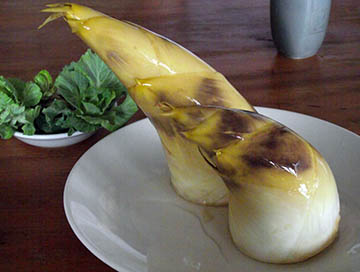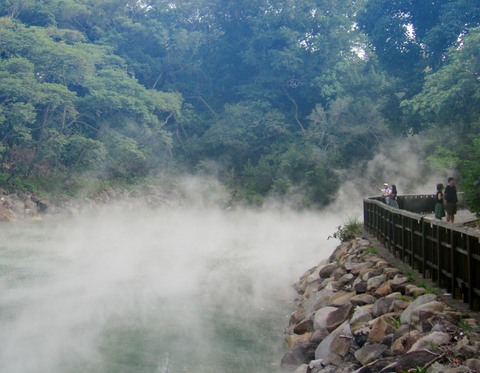My wife, two of her brothers, and I went to Taipei’s Beitou district to visit a nun she knew. The two had met when my wife's friend was visiting Denver. Today we visited her elegant mountain-side home on the base of Yangmingshan.
Upon arrival we paid respects at her shrine to Buddah. Then she invited us into her dining room. There we drank tea at a table which had a solid wood top about six inches thick. It came from a tree felled at least 40 years ago. The nun told us that good wood comes from slow growing trees while those which grow rapidly yield only poor wood.
The tea we drank was grown on Yangminshan at an elevation of close to 10,000 feet. Few places in Taiwan get winter snow, Yangmingshan is one of them.
As we chatted over tea, our host showed us some fresh bamboo shoots which had been grown on the mountainside behind her home. Her tea compared favorably with the local Iron Guan Yin tea I’d had at a tea house near the Maokong gondola station.
After tea we set out for lunch at The Lotus, a local vegetarian restaurant. Because I was a year older than she, our friend ordered noodles to wish me a long life. We ate crushed oil twist and vegetables wrapped in lettuce leaves, bitter melon, eggplant, mushroom tempura, and tofu with vegetables. The meal concluded with a soup of cabbage, mushrooms, corn, carrots, and noodles, as well as a desert of sliced apples oranges and guavas. Our host said that although the United States is large, there’s nothing to eat there. Taiwan is small yet it grows an enormous variety of food.
After lunch, we walked down Hot Spring Street to the entrance of Thermal Valley (also known as Hell Valley). A shaded path led to a spring from which hot steam arose. Formerly, people bathed at the confluence of the hot spring and a mountain stream. In recent years however, the spring has grown too hot and bathing is prohibited.
There are three types of sulfur springs. These include: green sulfur, iron sulfur and white sulfur — only two of these are suitable for bathing in.
There’s a reasonably priced public hot spring pool not far from Beitou's Thermal Valley. Bathing suits are required. The Beitou Hot Spring Museum is located near the public pool. Built as a public bath during Japan’s occupation of Taiwan, the museum displays historical and hot spring related artifacts.


